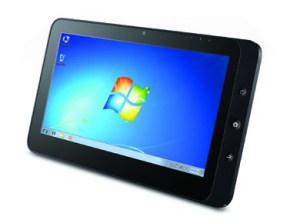
ViewSonic has formally announced it is bringing its ViewPad 7 and ViewPad 10 tablet computing devices to the U.S. market—and the 10-inch version will be able to book either Android 1.6 or Windows 7 Home Premium.
“Leveraging our 20-year display heritage, these new ViewPad solutions provide users with anytime anywhere connectivity,” said ViewSonic America’s VP and general manager Jeff Volpe, in a statement. “With access to the universe of Android apps, our new ViewPads are perfectly suited for enjoying digital entertainment and social media. Office productivity is also a snap with robust Web browsing functionality.”
The ViewPad 7 tablet sports an 800 by 480-pixel WVGA LCD display, 802.11b/g Wi-Fi and Bluetooth wireless connectivity, USB, two built-in cameras (a three-megapixel camera for pictures and a front-facing VGA camera for video chat), a microSDHC slot for up to 32GB of removable storage, 512MB of memory, and battery life of up to 10 hours. The ViewPad 7 will also sport 3.5-G-capable mobile data technology—that would be HSPA+—and can support Android Google Mobile Services, meaning users can tap into Android apps specifically for phones and mobile devices. The ViewPad 7 will run Android 2.2 “Froyo” and should hit U.S. retailers in “late Q4” for a suggested price of $479—putting it just under the price point of Apple’s least expensive, Wi-Fi-only iPad. Although, of course, if folks want mobile connectivity they’ll have to figure out how to get on a data plan.

ViewSonic originally showed the ViewPad 7 last August at the IFA trade show in Berlin; at the time, the company did not reveal pricing or availability information.
Folks looking to step up to a bigger screen may want to check out the ViewPad 10, but they’ll also have to wait a while longer, since it’s not due to be on sale until the first quarter of 2011. The ViewPad 10 is built around a 1.6 GHz Intel Atom processor and will be able to boot either Android 1.6 or Windows 7 Home Premium. The ViewPad 10 will offer 1 GB of memory, a 16 GB SSD drive, microSD removable storage, and will sport a 1,024 by 600-pixel display. The ViewPad 10 will include integrated Wi-Fi, a “G-sensor,” and capacitive multitouch for interacting with content and applications. The ViewPad 10 will also sport a 1.3 megapixel webcam. ViewSonic says more detailed specs will be coming soon, but the ViewPad 10 will carry a suggested price of $629.


